Get free scan and check if your device is infected.
Remove it nowTo use full-featured product, you have to purchase a license for Combo Cleaner. Seven days free trial available. Combo Cleaner is owned and operated by RCS LT, the parent company of PCRisk.com.
What kind of malware is Leet?
Leet is an Electron-based stealer that emerged in late autumn of 2024. This data-stealing program was initially offered as MaaS (Malware-as-a-Service) before its source code (alongside that of the Hexon stealer) was put on the market in the spring of 2025. Since then, several variants of this malware have been created; it is suspected that Leet served as a base for the RMC stealer.
It is noteworthy that Leet, alongside RMC and another stealer called Sniffer, have been spread through gaming-themed social engineering campaigns.
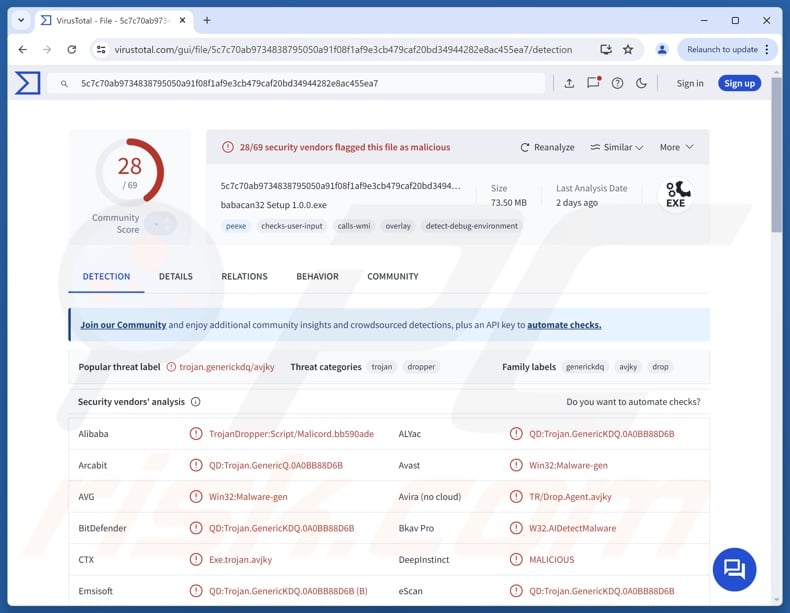
Leet malware overview
Leet utilizes anti-detection and anti-analysis techniques. One of its sandbox detection methods is cross-referencing the infected device's hostname, username, GPU, IP address, and running processes with its exclusion list.
As mentioned in the introduction, Leet is a stealer – a type of malware designed to exfiltrate sensitive information from infected machines. It can extract Internet cookies, auto-fills (e.g., personally identifiable details, usernames, etc.), and passwords from various browsers. Targeted browsers include Google Chrome, Chromium, Microsoft Edge, Opera, Brave, Vivaldi, and Yandex.
This program seeks to acquire information from other types of software as well. It can steal a wide variety of data from the Discord messenger (including the unofficial version dubbed BetterDiscord). The stealer also targets information associated with the WhatsApp and Telegram messengers, as well as gaming-related programs like Steam, Epic Games, Growtopia, and Minecraft.
Furthermore, Leet has the ability to download/install additional malicious components or programs onto systems. Software capable of this may cause any type of infection (e.g., trojans, ransomware, cryptominers, etc.) – however, in practice, these programs tend to operate within certain limitations or specifications.
According to the promotional material of Leet's initial version from 2024, it has also targeted cryptowallets and cryptocurrency-related browser extensions (e.g., Atomic, Exodus, MetaMask, etc.). This variant could also change the desktop wallpaper, play audio, execute PowerShell commands, and have remote desktop capabilities.
It must be mentioned that malware developers commonly improve upon their software and techniques. Therefore, possible future iterations of this stealer could retain the old features or have additional/different capabilities.
In summary, the presence of malicious software like Leet on a device can lead to multiple system infections, severe privacy issues, financial losses, and identity theft.
| Name | Leet malware |
| Threat Type | Trojan, stealer, password-stealing virus. |
| Detection Names | Avast (Win32:Malware-gen), Combo Cleaner (QD:Trojan.GenericKDQ.0A0BB88D6B), ESET-NOD32 (NSIS/TrojanDropper.Agent.ES), Fortinet (W32/Agent.ES!tr), Ikarus (Trojan-Dropper.NSIS.Agent), Full List Of Detections (VirusTotal) |
| Symptoms | Trojans are designed to stealthily infiltrate the victim's computer and remain silent, and thus no particular symptoms are clearly visible on an infected machine. |
| Distribution methods | Infected email attachments, malicious online advertisements, social engineering, software 'cracks'. |
| Damage | Stolen passwords and banking information, identity theft, the victim's computer added to a botnet. |
| Malware Removal (Windows) |
To eliminate possible malware infections, scan your computer with legitimate antivirus software. Our security researchers recommend using Combo Cleaner. Download Combo CleanerTo use full-featured product, you have to purchase a license for Combo Cleaner. 7 days free trial available. Combo Cleaner is owned and operated by RCS LT, the parent company of PCRisk.com. |
Stealer-type malware examples
We have investigated numerous malicious programs; SHUYAL, BOFAMET, Scruffy, Myth, and Amatera are just some of our latest articles on stealers.
This type of malware can seek a broad range of data or specific details only. What is more, data-stealing abilities are prevalent in all kinds of malware, and stealers are also used in combination with other programs.
It must be stressed that regardless of how a piece of malicious software operates – its presence on a system threatens device/user safety. Therefore, all threats must be removed immediately upon detection.
How did Leet infiltrate my computer?
Leet stealer has been proliferated through gaming-centered campaigns. These operations also distributed other stealers – RMC and Sniffer. It was spread under the names of yet-to-be-released as well as fake video games. The malware's executable files bore names related to setups, Steam, and indie games.
Some game titles used for the filenames include Catly, Eden, and Rooted – all listed on Steam but are unreleased as of the time of writing. However, as Steam does have an early access program, the availability of games prior to their official release has credence – and this is what the cyber criminals rely on.
Leet was also distributed under the guise of nonexistent games with strong social engineering campaigns complementing them. They were advertised on dedicated "official" websites and YouTube channels.
Some of the known samples are: Baruda Quest (with branding/artwork stolen from an actual game named Club Cooee), Warstorm Fire (stolen from Crossfire: Sierra Squad), WarHeirs (The Braves), and Dire Talon (Project Feline). Many of the sites were in Portuguese, with most suspected victims based in Brazil. However, a large number of users compromised through these campaigns were also located in the US and Turkey. These fake game websites were heavily promoted via Discord.
It is noteworthy that Leet could be distributed using other methods. Generally, phishing and social engineering are standard in malware distribution. Malicious software is typically disguised as or bundled with ordinary program/media files. Formats may differ, e.g., executables (EXE, RUN, etc.), archives (RAR, ZIP, etc.), documents (PDF, Microsoft Office, Microsoft OneNote, etc.), JavaScript, and so on.
The most prevalent distribution techniques include: backdoor/loader-type trojans, drive-by (stealthy/deceptive) downloads, malicious attachments/links in spam (e.g., emails, PMs/DMs, social media posts, etc.), malvertising, online scams, suspicious download sources (e.g., freeware and third-party websites, Peer-to-Peer sharing networks, etc.), illegal software activation tools ("cracks"), and fake updates.
What is more, some malicious programs can self-proliferate through local networks and removable storage devices (e.g., external hard drives, USB flash drives, etc.).
How to avoid installation of malware?
We strongly recommend vigilance when browsing since the Internet is rife with deceptive and malicious content. Incoming emails and other messages must be approached with caution. Attachments or links found in suspicious/irrelevant mail must not be opened, as they can be virulent.
Additionally, all downloads must be made from official and verified sources. Another recommendation is to activate and update software employing functions/tools provided by legitimate developers, as illegal activation ("cracking") tools and third-party updaters can contain malware.
It is essential to have a reputable antivirus installed and kept up-to-date. Security programs must be used to run regular system scans and to remove detected threats. If you believe that your computer is already infected, we recommend running a scan with Combo Cleaner Antivirus for Windows to automatically eliminate infiltrated malware.
Screenshots of fake game websites spreading Leet malware (image source – Acronis):
Instant automatic malware removal:
Manual threat removal might be a lengthy and complicated process that requires advanced IT skills. Combo Cleaner is a professional automatic malware removal tool that is recommended to get rid of malware. Download it by clicking the button below:
DOWNLOAD Combo CleanerBy downloading any software listed on this website you agree to our Privacy Policy and Terms of Use. To use full-featured product, you have to purchase a license for Combo Cleaner. 7 days free trial available. Combo Cleaner is owned and operated by RCS LT, the parent company of PCRisk.com.
Quick menu:
How to remove malware manually?
Manual malware removal is a complicated task - usually it is best to allow antivirus or anti-malware programs to do this automatically. To remove this malware we recommend using Combo Cleaner Antivirus for Windows.
If you wish to remove malware manually, the first step is to identify the name of the malware that you are trying to remove. Here is an example of a suspicious program running on a user's computer:
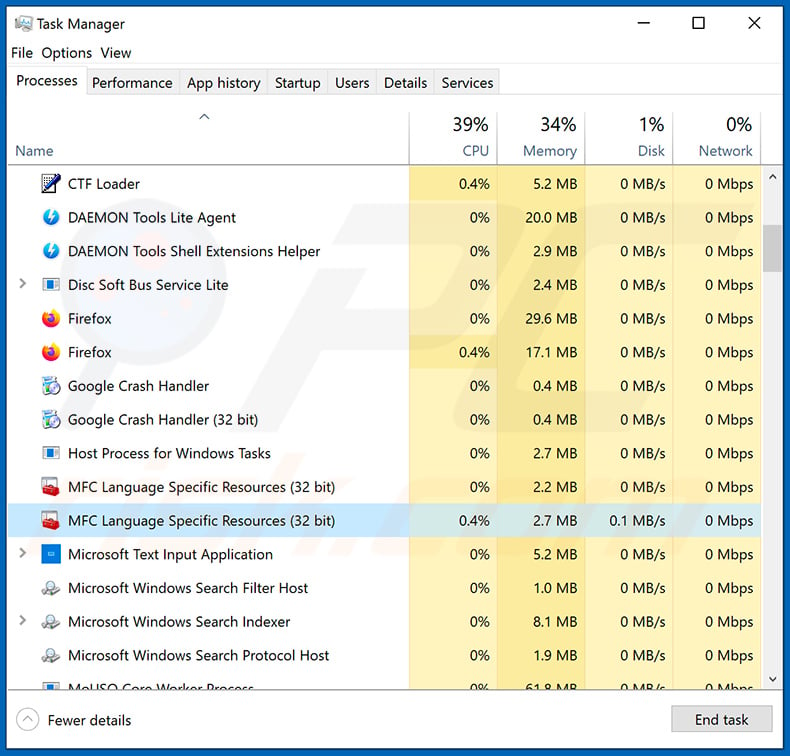
If you checked the list of programs running on your computer, for example, using task manager, and identified a program that looks suspicious, you should continue with these steps:
 Download a program called Autoruns. This program shows auto-start applications, Registry, and file system locations:
Download a program called Autoruns. This program shows auto-start applications, Registry, and file system locations:
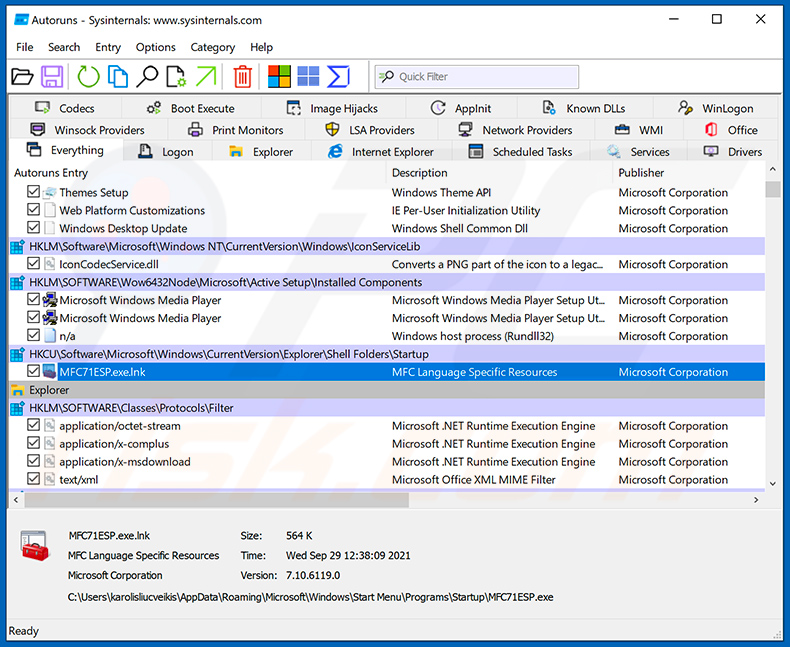
 Restart your computer into Safe Mode:
Restart your computer into Safe Mode:
Windows XP and Windows 7 users: Start your computer in Safe Mode. Click Start, click Shut Down, click Restart, click OK. During your computer start process, press the F8 key on your keyboard multiple times until you see the Windows Advanced Option menu, and then select Safe Mode with Networking from the list.
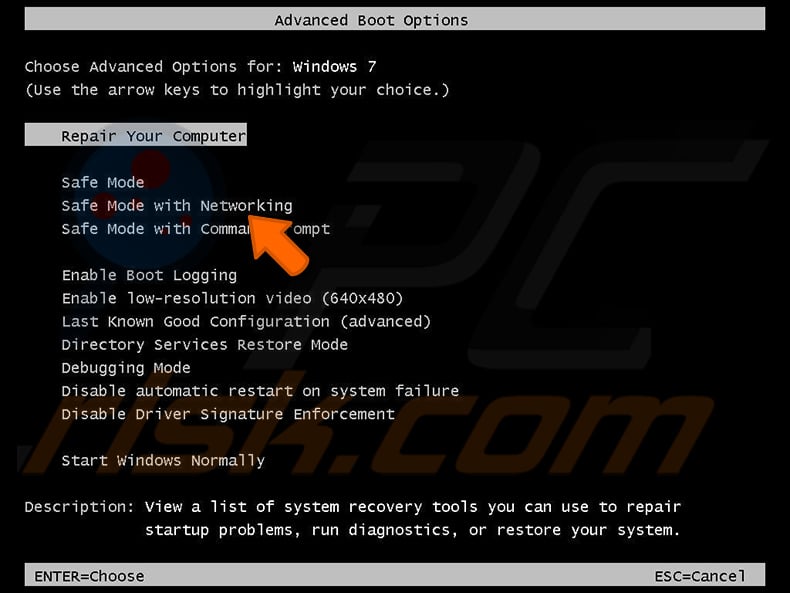
Video showing how to start Windows 7 in "Safe Mode with Networking":
Windows 8 users: Start Windows 8 is Safe Mode with Networking - Go to Windows 8 Start Screen, type Advanced, in the search results select Settings. Click Advanced startup options, in the opened "General PC Settings" window, select Advanced startup.
Click the "Restart now" button. Your computer will now restart into the "Advanced Startup options menu". Click the "Troubleshoot" button, and then click the "Advanced options" button. In the advanced option screen, click "Startup settings".
Click the "Restart" button. Your PC will restart into the Startup Settings screen. Press F5 to boot in Safe Mode with Networking.
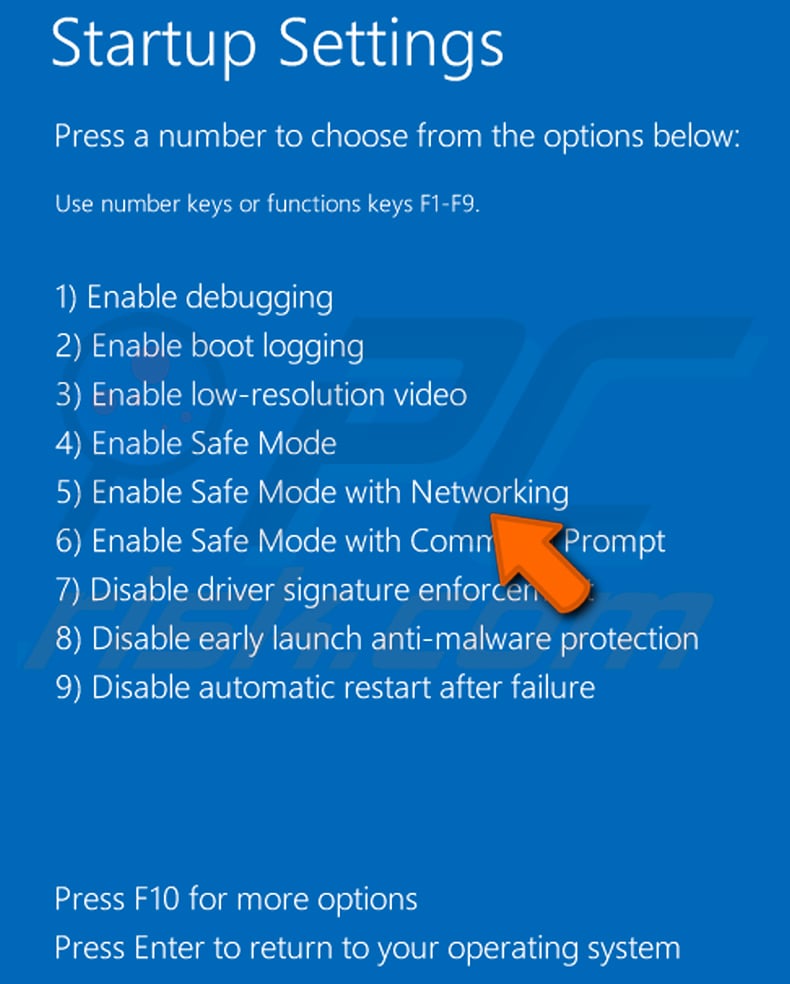
Video showing how to start Windows 8 in "Safe Mode with Networking":
Windows 10 users: Click the Windows logo and select the Power icon. In the opened menu click "Restart" while holding "Shift" button on your keyboard. In the "choose an option" window click on the "Troubleshoot", next select "Advanced options".
In the advanced options menu select "Startup Settings" and click on the "Restart" button. In the following window you should click the "F5" button on your keyboard. This will restart your operating system in safe mode with networking.
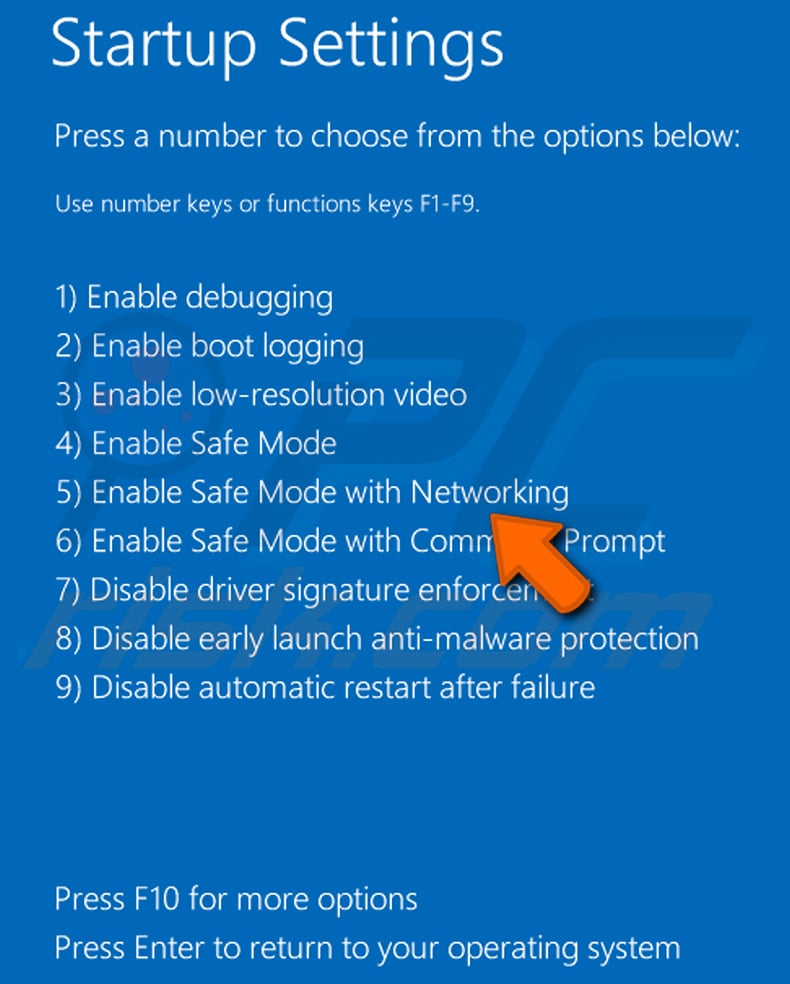
Video showing how to start Windows 10 in "Safe Mode with Networking":
 Extract the downloaded archive and run the Autoruns.exe file.
Extract the downloaded archive and run the Autoruns.exe file.
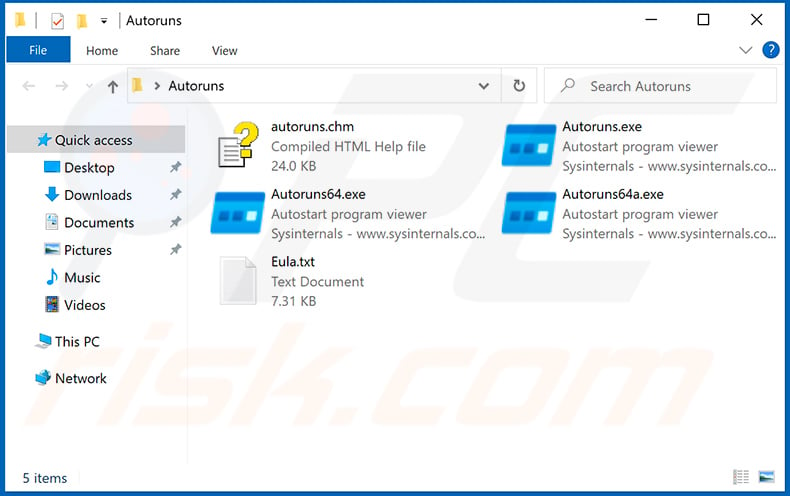
 In the Autoruns application, click "Options" at the top and uncheck "Hide Empty Locations" and "Hide Windows Entries" options. After this procedure, click the "Refresh" icon.
In the Autoruns application, click "Options" at the top and uncheck "Hide Empty Locations" and "Hide Windows Entries" options. After this procedure, click the "Refresh" icon.
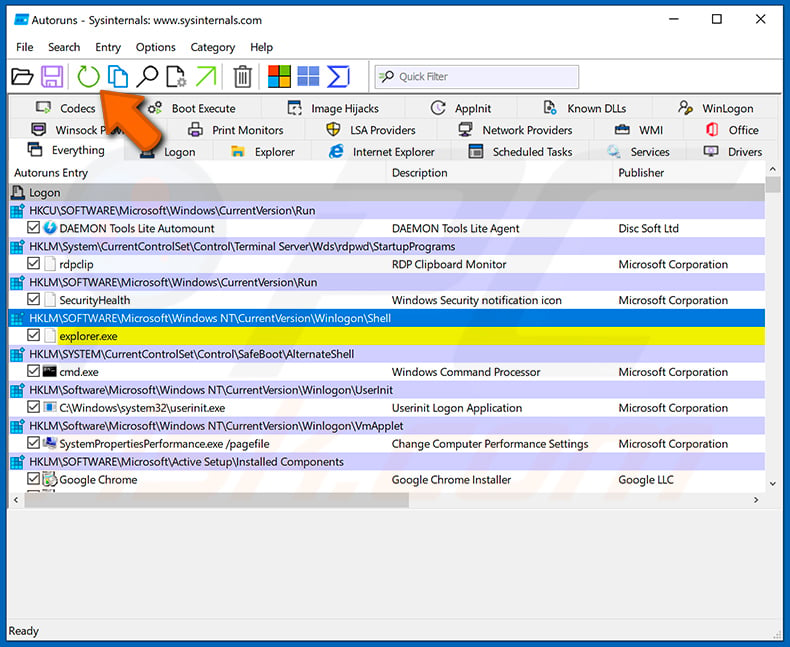
 Check the list provided by the Autoruns application and locate the malware file that you want to eliminate.
Check the list provided by the Autoruns application and locate the malware file that you want to eliminate.
You should write down its full path and name. Note that some malware hides process names under legitimate Windows process names. At this stage, it is very important to avoid removing system files. After you locate the suspicious program you wish to remove, right click your mouse over its name and choose "Delete".
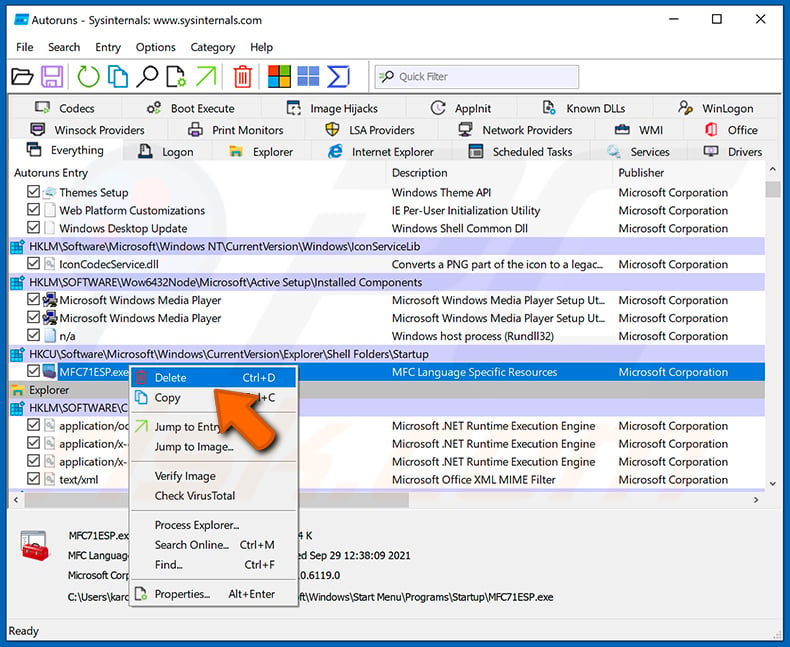
After removing the malware through the Autoruns application (this ensures that the malware will not run automatically on the next system startup), you should search for the malware name on your computer. Be sure to enable hidden files and folders before proceeding. If you find the filename of the malware, be sure to remove it.
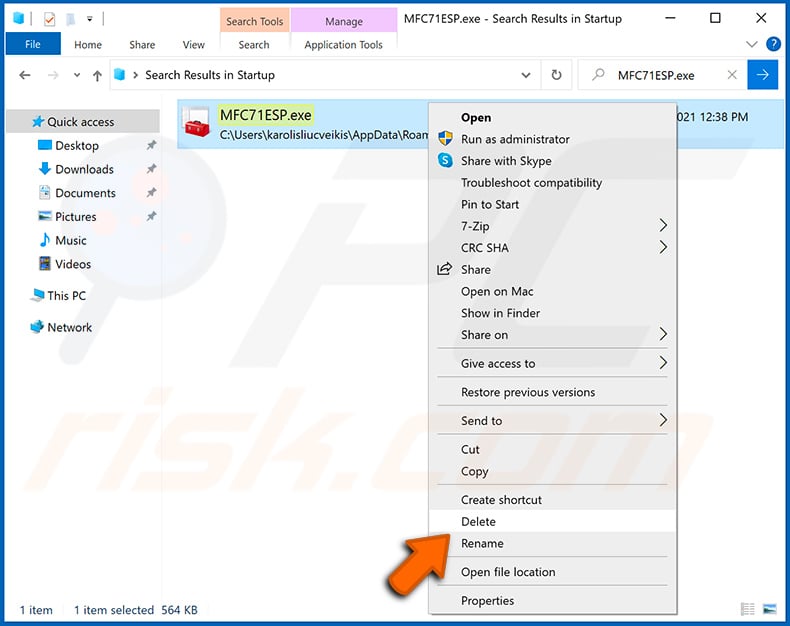
Reboot your computer in normal mode. Following these steps should remove any malware from your computer. Note that manual threat removal requires advanced computer skills. If you do not have these skills, leave malware removal to antivirus and anti-malware programs.
These steps might not work with advanced malware infections. As always it is best to prevent infection than try to remove malware later. To keep your computer safe, install the latest operating system updates and use antivirus software. To be sure your computer is free of malware infections, we recommend scanning it with Combo Cleaner Antivirus for Windows.
Frequently Asked Questions (FAQ)
My computer is infected with Leet malware, should I format my storage device to get rid of it?
Malware removal rarely requires formatting.
What are the biggest issues that Leet malware can cause?
The threats posed by an infection depend on the malware's functionalities and the attackers' goals. Leet is designed to steal vulnerable data and cause chain infections. Generally, the presence of such software can lead to multiple system infections, severe privacy issues, financial losses, and identity theft.
What is the purpose of Leet malware?
Malware is predominantly used to generate revenue for the attackers. However, it can also be used to amuse the cyber criminals or realize their grudges, disrupt processes (e.g., sites, services, companies, organizations, etc.), engage in hacktivism, and launch politically/geopolitically motivated attacks.
How did Leet malware infiltrate my computer?
Leet stealer has been spread as both existent and nonexistent video games promoted through Discord. Other distribution methods are not unlikely.
Popular malware proliferation techniques include: trojans, drive-by downloads, suspicious download sources (e.g., freeware and third-party sites, P2P sharing networks, etc.), online scams, spam emails/messages, malvertising, illegal software activation tools ("cracks"), and fake updates. What is more, some malicious programs can self-spread via local networks and removable storage devices.
Will Combo Cleaner protect me from malware?
Combo Cleaner is capable of detecting and eliminating most of the known malware infections. It must be emphasized that performing a complete system scan is paramount since high-end malicious programs tend to hide deep within systems.
Share:

Tomas Meskauskas
Expert security researcher, professional malware analyst
I am passionate about computer security and technology. I have an experience of over 10 years working in various companies related to computer technical issue solving and Internet security. I have been working as an author and editor for pcrisk.com since 2010. Follow me on Twitter and LinkedIn to stay informed about the latest online security threats.
PCrisk security portal is brought by a company RCS LT.
Joined forces of security researchers help educate computer users about the latest online security threats. More information about the company RCS LT.
Our malware removal guides are free. However, if you want to support us you can send us a donation.
DonatePCrisk security portal is brought by a company RCS LT.
Joined forces of security researchers help educate computer users about the latest online security threats. More information about the company RCS LT.
Our malware removal guides are free. However, if you want to support us you can send us a donation.
Donate




▼ Show Discussion